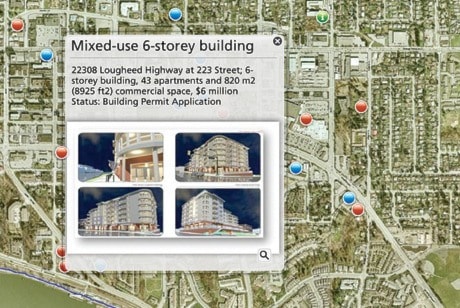Last October, Maple Ridge’s plan for boosting building in the downtown produced $22 million in construction projects.
By December, that jumped by 50 per cent, to $33 million.
Add on projects that are in the application process and the number rises to $110 million.
Not bad for the first year of the District of Maple Ridge’s town centre investment program, which offers cash rebates for development fees, reductions in building permit fees and property tax exemptions as a way to entice downtown development.
Tuesday, council reviewed a staff report on the first year of the three-year plan, which expires December 2013.
“It’s interesting what pushes their [developers] buttons,” said Mayor Ernie Daykin.
He figures the program’s goal of fast-tracking downtown projects through the district’s application process is as important as the financial breaks.
“Because time is money, too.”
Daykin, though, is looking beyond the plan to a decade into the future.
“Looking forward to five years from now, it’s going to be pretty dramatic.”
He sees Maple Ridge’s downtown changing first into something like Port Coquitlam, then into Coquitlam, with its steel-and-glass towers.
“We’re still a ways away from that concrete, high-rise market. Does that mean we just stop everything? I don’t think so.”
He says downtown will survive any commercial competition outside its borders, such as in Albion flats, if the Agricultural Land Commission allows shopping development of that area.
“Are there going to be some challenges?” It would be naive to think so, he added.
“The large-format retail does keep people at home, too,” said Daykin, who used to run Windsor Plywood store in Albion industrial area.
In the last year, the downtown incentives have generated 31 new projects resulting in nearly 1,200 new town homes and condominiums and another 27,000 sq. metres of commercial space.
A staff report says council could extend the geographic boundaries of the program beyond the downtown. The time for the program could also be extended. But it recommends against both.
But the latter should be considered, said Coun. Al Hogarth.
He also pointed out the program offers incentives to both builders – and to the future buyers, such as residential and strata purchasers who would get property tax breaks for a few years.
Hogarth pointed out the program could be bringing in more money to the district than $500,000 it’s currently costing. He crunched the numbers on one project, comparing the tax revenue to the district before and after, and found there was a 200-per-cent increase in revenues to the district.
He knows of at least one developer whose mind was made up because of the program.
On the other hand, having an expiry date, December 2013, provides some motivation, said Daykin.
“You create urgency. You build on excitement.” The district doesn’t have unlimited money to spend on the project, the mayor added.
Coun. Mike Morden has the same view. Let the project run for three years then evaluate it when it’s over. It’s currently costing Maple Ridge a half a million a year, he pointed out.
“For me, I would leave it at three years.”
The strategy has attracted the B.C. Brown Field Renewal Strategy, which is creating a model based on Maple Ridge’s plan for other B.C. cities.
• All of the major projects currently underway in the downtown have participated in the program, including Thrifty Foods and Haney Place Mall, Great Canadian Gaming, the builder of the hotel on 224th Street along with three mixed-use projects with both commercial and residential.
Incentives include the district paying up to $75,000 to cover part of the development charges on a green, four-storey apartment project, to more than 50-per-cent discounts for building permits, to fast-tracking projects, to exemption from property taxes for either three or six years.
• The incentives available depend on whether it’s a residential or commercial project, if it’s a four or five-story building, the location in the downtown and if it’s a green, LEED-certified project.
• Daykin said the district is still awaiting an application from Smart Centres and other land owners for excluding the western portion of Albion flats on Lougheed Highway and 105th Avenue from the Agricultural Land Reserve. The district wants to see that application before it does its own application for exclusion on the east side of 105th Avenue.
“If we don’t see something … by May at the latest. It’s got to be a real strong application.”
But so far he’s heard no word from the landowners.
